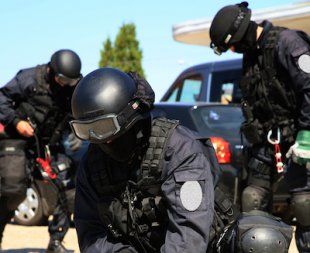
The federal bureaucratic pipeline that has pumped billions in surplus military weapons and battle gear into thousands of police departments across America does not train cops to use them, does not track when the weaponry is used and does not screen police for history of civil rights abuses. It also does not want to decide whether it is even appropriate to be sending local police weapons as esoteric as rifle bayonettes and combat knives.
These were just some takeaways from a lengthy hearing in the Senate Homeland Security and Governmental Affairs Committee on Tuesday, where top officials from the Pentagon, Department of Homeland Security, and Department of Justice described programs that funneled upwards of $50 billion in gear and grants in recent years to local police. The hearing is expected to prompt a major revamping of these programs, as almost every senator who spoke up, both Democrat and Republican, slammed militarized policing.
“How do they decide that an MRAP [mine-resistant ambush protected armored truck] is appropriate for my hometown of 35,000 people,” Sen. Tom Coburn, R-Oklahoma, asked Alan Estevez, an under-secretary of defense overseeing the Pentagon’s giveaways, who replied that governors’ offices file the requests to get the free equipment. “But how do you decide that an MRAP is an appropriate vehicle for local police forces?” Coburn said, pressing on. “An MRAP is a truck, senator,” Estevez replied, at which point Coburn abruptly cut him off. “No, it’s not a truck. It’s a 48,000-pound offensive weapon.”
That exchange was not unique. Missouri Democratic Senator Claire McCaskill, a former prosecutor, said she wasn’t buying the explanation given by St. Louis-area police for driving an armored truck into the protests in Ferguson, where a police sniper then aimed a laser-guided scope mounted atop an assault rifle at the crowd.
“Is there somewhere in the training where that’s appropriate,” she asked Mark Lomax, National Tactical Officers Association executive director. Lomax ducked the question, saying he would let the FBI investigation of what happened in Ferguson answer what was appropriate. McCaskill chairs the panel’s Subcommittee on Financial and Contracting Oversight.
“Believe it or not, I was told that the reason that happened was that he was using his scope in order to observe the crowd. Well, have they heard of binoculars?” an indignant McCaskill told other senators. “It seems to me there is a better way to monitor a crowd that is peacefully protesting than pointing mounted sniper weapons at them… It seems common sense would tell you that’s going to make the situation much worse.”
The senators also heard from police lobbyists, who emphasized that most of the gear they get from the military is office equipment—although by the hearing’s end they conceded that new accountability and training for donated weaponry was overdue. The panel also heard from academics and civil rights leaders who said that American policing has been increasingly militarized since the 1980s war on drugs, which has led police to cultivate a mindset of preparing for battle instead of less confrontational community policing.
“What we saw played out in the Ferguson protests was the application of a very common mindset, style of uniform, appearance and weaponry, used every day in the homes of private residences during SWAT raids,” said Peter B. Kraska, professor, School of Justice Studies, University of Eastern Kentucky. He added these raids are now routine—60,000 a year, compared to 3,000 a year before the war on drugs. “This has devolved now into what I’m talking about—widespread misapplication of the paramilitary model. Misapplication, unjustified growth in many, many, many small police departments.”
Kraska said that the heavy-handed police response in Ferguson was predictable, given not just the gear, but the “warrior” mindset and way local police are widely trained.
“What you saw was a high level of fear of victimization among the police,” he said. “It’s a huge cultural issue right now in policing, where so many for-profit training groups and training academies are teaching this survivalist, warrior mentality. You never know if the next person is gonna kill you. You have to go home at night. So you take every possible precaution… It does lead to an intense fear of the ‘other,’ of ‘those people,’ of the community that you are serving.”
The senators heard eyewitness accounts of how the overly militarized police response to protesters in Ferguson made tensions worse.
“The distance between the police and protesters was probably 100 feet,” said Wiley Price, a photographer with the St. Louis American newspaper, who said he was pushed around by police. “Even when the police were shouting orders to us, like in that photo [the MRAP sniper], you can clearly hear whatever the police was saying… The police aggravated peaceful marchers, when they were just standing there chanting. Instead of just letting them chant, they moved them around, which irritated them.”
The Bureaucratic Pipeline
Tuesday’s hearing was the Senate’s first look into the federal government’s programs that transfer surplus military supplies and weapons for free to police. The White House is reviewing these programs at the same time the Justice Department has launched a civil rights investigation into the killing of Michael Brown by a Ferguson officer.
“I think most Americans were uncomfortable watching a suburban street in St. Louis being transformed with vivid images into a war zone, complete with camoflage, tear gas, rubber bullets, armored vehicles, and laser sights on assault weapons,” McCaskill said, in her opening remarks. “While this hearing may reveal many strong arguments why some of this equipment may be helpful for the safety of police officers in certain situations, I am confident that militarized policing tactics are not consistent with the peaceful exercise of First Amendment rights of free speech and free assembly… Those lawful peaceful protesters did not deserve to be treated like enemy combatants.”
But as the hearing unfolded, what emerged was a mutually benefical dynamic between federal agencies—at the Penatgon, Homeland Security and Justice Department—in which local police forces essentially help the Pentagon clear out its proverbial closet of supplies and weapons that were bought by taxpayers for overseas wars and barely used.
In the past three years, the Pentagon has given 624 MRAPs to state and local law enforcement agencies with little regard for need or size of the department, McCaskill said. At least 13 local police agencies with fewer than 10 full-time officers received one MRAP, she said, saying that local police departments in Texas were given 73 MRAPs, while the Texas National Guard only received six vehicles. Florida local police departments have received 45, she said, while its National Guard got none.
Roughly one-third of the Pentagon weaponry transferred to local police was unused or almost new, McCaskill said, which raised questions about why the military is buying supplies it is almost immediately giving away. If the gear wasn’t provided free, then grants from the Homeland Security and Justice Departments helped to pay for it.
Estevez, the Pentagon’s Principal Deputy Under-Secretary of Defense for Acquisition, Technology and Logistics, told the senators the giveaway program was designed for “good stewardship.” He said more than 8,000 of the country’s 17,000 local police agencies participate in the program, which has provided more than $5.1 billion “in property” since 1997. Governors’ offices make the requests, Estevez said, adding, “The Department of Defense does not have the expertise in police force functions and cannot assess how equipment is used in the possession of local law enforcement agencies.”
That last statement—that the Pentagon does not track how its equipment is used—was echoed by Estevez’s colleagues at Homeland Security and Justice Departments, who, he told the senator, he had never met before Tuesday’s hearing.
In the past 12 months, of the 1.9 million pieces of equipment given away, 78,000 were military-grade arms or “controlled property,” Estevez said. “Law enforcement agencies currently possess 460,000 pieces of controlled property that they have received over time.” Examples of controlled property include over 92,000 small arms, 44,000 night-vision devices, 5,200 high-mobility multi-purpose vehicles or Humvees, and 617 mine-resistant ambush protected vehicles, or MRAPS. The Department does not provide tanks, grenade launchers, sniper rifles, current service weapons or uniforms, he said. (His numbers slightly differed from figures cited by McCaskill.)
Estevez said much of this former military gear has been used in emergencies, such as during major storms and floods. He said MRAPs have been used to protect police in shootouts with gangs and kidnappings. Brian E. Kamoie, assistant administrator for grant programs at the Federal Emergency Management Agency, which is part of the Department of Homeland Security, repeatedly said that local police in Boston used helicopter-mounted scopes to track down one of the Boston Marathon bombers.
However, many of the senators weren’t buying these explanations. Coburn said the Boston bomber claim was ridiculous, because a homeowner called 911 after he saw blood on his boat in his backyard. None of the ex-military equipment has ever been used to stop a domestic terrorist attack, he said. Wisconsin Democratic Sen. Tammy Baldwin asked the Justice Department, which described better internal tracking than the Pentagon, if it checked whether police departments sued for civil rights abuses were receiving military equipment. Karol Mason, the Assistant Attorney General for the Office of Justice Programs, said no, but, “of course, it could be.”
Baldwin also asked what training was provided for police who get military weaponry.
“These pieces of equipment are not traditional police equipment and may be very unfamilar to many police officers and sheriff’s deputies in communities across this country,” she said to Estevez. “Can you tell me if the DLA [Pentagon] review or the original application process makes any inquiry at all as to whether the agency has the appropriate training, or access to the appropriate training, to use and maintain this equipment? Or if, after the fact, if the equipment is being properly used?”
“The DLA—the Defense Logistics Agency—which facilitates the program doesn’t have that capability,” he said. “Neither does the Department of Defense as a whole. We can’t manage local police forces. Even equipment that we are trained to use is for combat operations, not for local policing operations… The state coordinator certifies that a local police force that’s going to receive an item has the ability themselves to use it.”
These answers prompted the senators to ask police lobbyists how they thought local departments would react if they faced new regulations about getting and using surplus military weapons, from training to possibly managing them on a regional and shared basis. Those lobbyists, seeing the likelihood that the Senate would try to reform the giveaway programs, predicted that police would not object—especially should training dollars come with the giveaways.
But Kraska, the political scientist who has studied police militarization for decades, told the senators that there were deeper obstacles, such as the culture in policing that values weaponry and security above community policing and humanitarian service. He gave the example of the police response after Hurricane Katrina, where many law enforcement agencies spent four days securing the region instead of delivering needed aid.
“These examples are emblematic of a historic, but up until recently, little publicly noted shift in American democratic governance,” he said. “The research I have been conducting since 1989 has documented qualitatively and quantitatively, the steady and certain march of U.S. civilian policing down the militarization continuum—culturely, materially, operationally and organizationally—despite a massive effort at democratizing police under the guise of community policing reforms. The growth in militarized policing has been steep and deep.”
Steven Rosenfeld covers national political issues for AlterNet, including America’s retirement crisis, the low-wage economy, democracy and voting rights, and campaigns and elections. He is the author of “Count My Vote: A Citizen’s Guide to Voting” (AlterNet Books, 2008).















